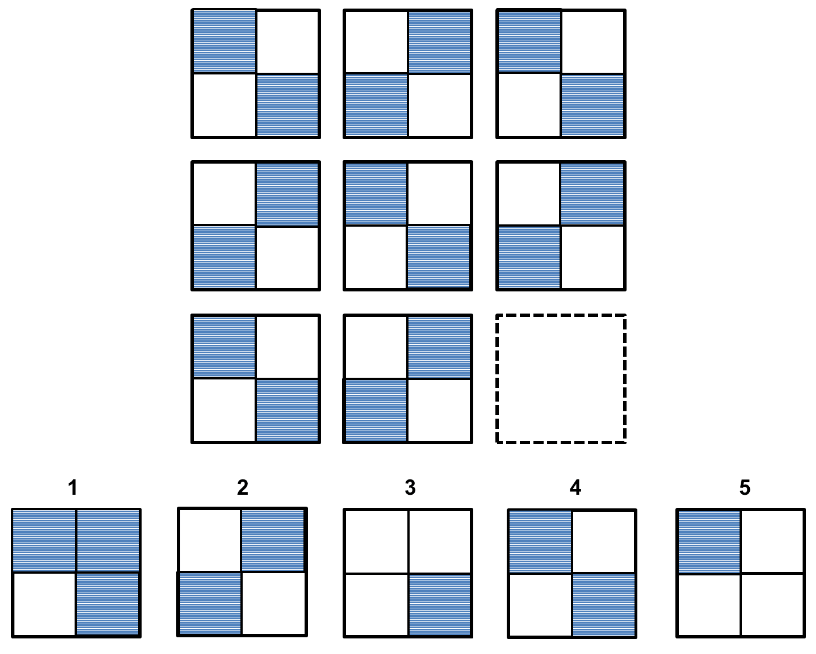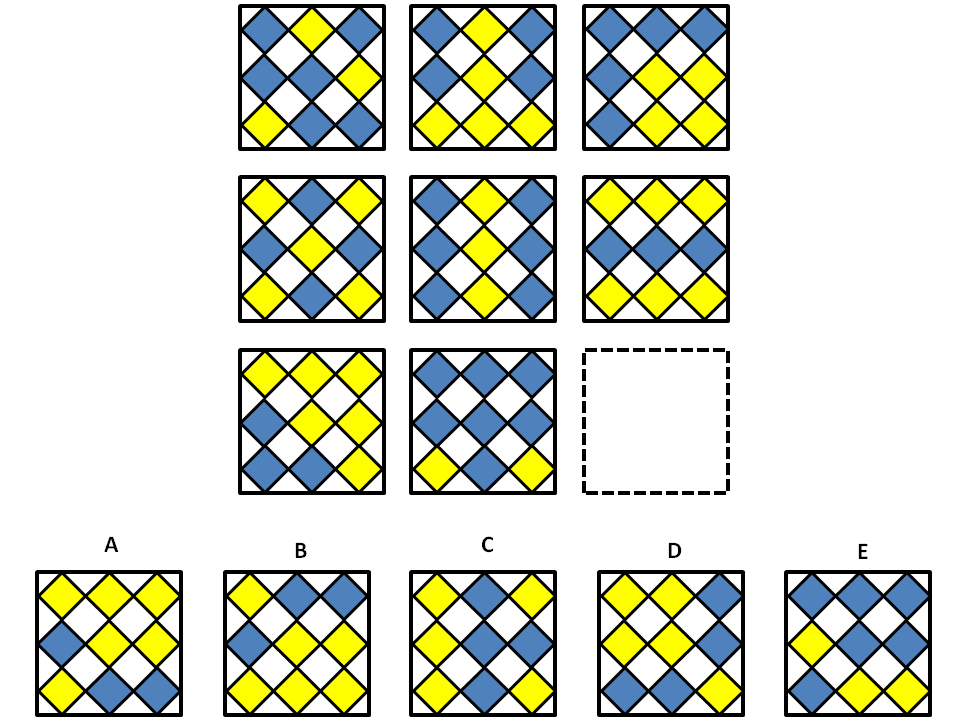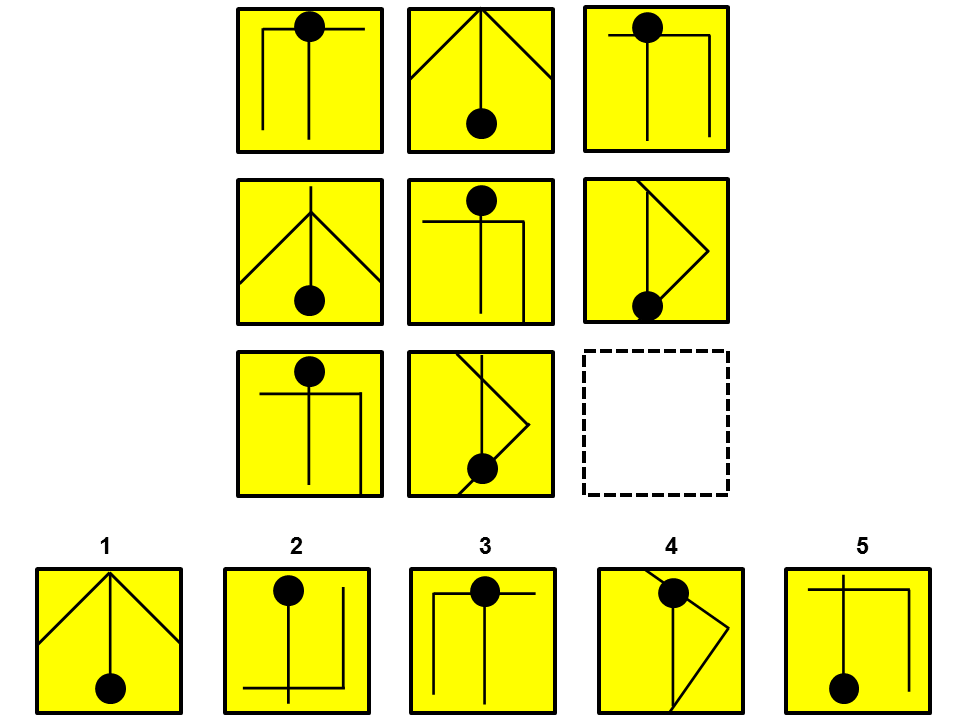Last Updated: November 18, 2025
The FBI Phase 1 Test is an approximately 3-hour exam designed to evaluate your reasoning, judgment, and personality, and it’s the first major step in becoming a Special Agent. Fewer than 1 in 3 applicants pass on their first attempt.
This page gives you a complete breakdown of the test format, with free real sample questions, expert tips, and full prep for both Phase 1 and Phase 2, so you know what to expect and how to prepare effectively.
What is the FBI Phase 1 Test?
The FBI Phase 1 Test is an approximately 3-hour, computer-based multiple-choice exam used to screen candidates for the Special Agent role.
It includes five timed sections that assess logical reasoning, visual pattern recognition, personality traits, and career preferences, each measuring a different skill set used in FBI fieldwork. Candidates must pass all sections to advance to Phase 2.
What’s on the FBI Phase 1 Test?
|
Section |
Number of Questions |
Skills Assessed |
|---|---|---|
|
Logical Reasoning |
11 |
Deductive reasoning, pattern recognition, logic |
|
Figural Reasoning |
9 |
Visual pattern recognition, spatial reasoning |
|
Personality Assessment |
100 statements |
Personality traits, behavioural tendencies |
|
Preferences and Interests |
11 |
Career and task preferences |
|
Situational Judgment Test |
19 |
Decision-making, judgement, ethics, FBI core values |
Sample Test Questions
FBI Phase 1 Logic Based Reasoning
The FBI Logical Reasoning Test measures your ability to attend to detail, evaluate information, and make sound judgments and decisions. This section contains 11 questions.
Each question presents a set of facts, and you must determine the correct conclusion from five options. Try the sample questions below.
FBI Practice Test - Logic Question #1
A percipient witness a.k.a. an eyewitness, is one who testifies about his or her knowledge of a crime as perceived through his/her senses (e.g., seeing, hearing, smelling, touching). Although juries and decision-makers place great reliance on eyewitness identification, they are often unaware of the danger of false memories. When an eyewitness identifies a person in a line-up, he is likely to identify that same person in later line-ups, even when the person identified is not the perpetrator. In a recent and particularly complex murder case still under investigation, Alice Wonder acted as an eyewitness in several line-ups. However, due to the false memory effect, most of her identification attempts thus far have turned out to be wrong.
From the information given above, it can be validly concluded that-
💡 By practicing beforehand, you can sharpen your logic-based reasoning skills and learn to solve questions much faster. This will also help you stay calm during the test and improve your score significantly. The FBI Test PrepPack has 6 Logic-Based Reasoning practice tests to help you, with 7 extra practice tests if you want to push your skills even further!
FBI Practice Test - Logic Question #2
According to the Uniform Crime Reporting (UCR) Program, the victim of a hate crime may be an individual, a business, an institution, or society as a whole. In 2014, the nation’s law enforcement agencies reported that there were 6,727 victims of hate crimes. Of these victims, some were victimized in multiple-bias incidents. An analysis of data for victims of single-bias hate crime incidents showed that 48.3 percent of the victims were targeted because of the offenders’ bias against race; 18.7 percent were targeted because of bias against sexual orientation; 1.4 percent were targeted because of bias against disability, and 0.6 percent were victims of gender bias. Of the victims targeted due to sexual-orientation bias in single-bias hate crimes, 56.3 percent were victims of crimes motivated by their offenders’ anti-gay (male) bias; 24.4 percent were victims of anti-lesbian, gay, bisexual, or transgender (mixed group) bias; 13.9 percent were victims of anti-lesbian bias; 3.8 percent were victims of anti-bisexual bias, and 1.5 percent were victims of anti-heterosexual bias.
From the information given above, it can be validly concluded that-
FBI Practice Test - Logic Question #3
Most burglars that break into homes are out for cash, jewellery, and electronics. Many are driven by addiction, looking for a quick buck. A few, however, break-in with the intention of hurting the residing families. Although most burglars would be deterred by signs that people are at home - such as noises, music being played or the lights left on - some might assume no one is home and break in anyway, even if they are wrong. Others just don't care.
From the information given above, it can be validly concluded that-
Want More FBI Practice Test Questions?
The best way to ace your upcoming exam is to familiarize yourself with the test format and question difficulty. Our PrepPack includes a diagnostic exam, to determine which areas you should focus on, as well as over 20 practice tests with accurate questions and thorough explanations. You will be able to replicate the FBI exam with an accurate simulation and learn all of the best expert tips with our study guides.
FBI Phase 1 Figural Reasoning
This fugural reasoning section assesses your ability to identify shape or image patterns and complete them accordingly. There will be 9 questions, each containing a sequence of shapes or symbols with one missing shape.
FBI Practice Test - Figural Reasoning Question #1
Identify the missing symbol following the logical sequence of the matrix.

💡 In our full FBI PrepPack™, you’ll find dozens of Figural Reasoning practice questions just like the ones in this FBI entrance exam practice test and just like the ones on the real FBI test. This tool will help you prepare for every question type you’ll encounter on the actual exam.
FBI Practice Test - Figural Reasoning #2
Identify the missing symbol-

FBI Practice Test - Figural Reasoning Question #3
Identify the missing symbol-

FBI Phase 1 Personality Assessment
The following questions are exemplary of what you may find on the personality assessment section. Though the have no "right" answer as this is a personality test, the picture your answers will paint can drastically affect your chances of employment as an FBI Special Agent.
FBI Practice Test - Personality Assessment Questions
Each item consists of 2 different statements that belong to 2 different personality traits. For each set of statements, you must select "agree" for one but "disagree" with the other.
💡 To choose your answers wisely and showcase your strengths, our FBI Test Practice Pack includes a detailed guide on the expected personality profile of promising FBI agents, with a personality practice test and detailed personal feedback.
FBI Phase 1 Preferences and Interests
The Preferences and Interests section is designed to evaluate how your natural inclinations and career preferences align with the role of an FBI Special Agent. This part of the test isn’t about right or wrong answers—instead, it measures whether your interests, values, and work style are a good fit for the agency’s mission and demands.
You’ll be presented with a series of statements or tasks and asked to rate your level of interest or agreement. These responses help the FBI determine if you’re likely to thrive in a law enforcement and investigative environment.
FBI Practice Test - Preferences and Interests
Rate how much you would enjoy the following activity:
“Reviewing financial records to detect fraudulent activity.”
This question evaluates your interest in investigative and analytical work—key aspects of an FBI Special Agent’s role. A high interest in tasks like reviewing financial records suggests you’re detail-oriented, patient, and comfortable working with data to uncover hidden patterns or irregularities. These are valuable traits in criminal investigations, especially in areas like white-collar crime, cybercrime, and counterintelligence. While there are no right or wrong answers, showing genuine interest in core investigative tasks may increase your alignment with the role.
FBI Phase 1 Situational Judgement Test
There are 19 questions in this section of the FBI test. Each question contains a description of a work scenario, followed by a list of possible responses. Remember that your answers should align with the FBI's core values and capabilities of an FBI agent.
FBI Practice Test - Situational Judgement Question #1
Hillary is a relatively new employee in your team. Yesterday you have given her a task that should be ready by the end of today. At lunch, she approaches you and says that it took her a long time to familiarize herself with the task and now she is worried that she won’t finish on time. Up until now, Hillary has proved to be a competent employee and has never failed to meet deadlines.
How would you respond?
FBI Practice Test - Situational Judgement Question #2
In your weekly meeting, your manager casually mentions that one of the customers told him about an error that was made by your team. This could have been a serious issue, but fortunately the customer noticed it in time and was able to fix it by himself.
What would you say to your manager?
FBI Practice Test - Situational Judgement Question #3
One of your team members is asking to meet with you. In the meeting, he says that he feels that the tasks you assigned him are harder than those you assigned other people, and that because of this he is constantly staying extra hours to meet your deadlines.
What is your first response?
💡When addressing these questions, you need to consider the FBI’s core values: integrity, respect, accountability, leadership, diversity, excellence, and teamwork. FBI Special Agents must uphold the highest ethical standards, value others’ rights and dignity, and take responsibility for their actions. They are expected to lead in challenging situations, embrace diversity, and strive for continuous improvement. Collaboration and teamwork are also crucial, as agents work together to achieve common goals while maintaining professionalism and dedication.
FBI Practice Test Phase 2
After completing the FBI Special Agent Phase 1, you will be invited to take the FBI Special Agent Phase 2 test.
It consists of 2 parts: a 150-minute writing assessment and a 1-hour structured interview.
Writing Assessment
You'll receive data and have two and a half hours to analyze it and generate two reports. Your reports must demonstrate thoroughness, organization, and impeccable grammar, spelling, and punctuation. The prompt typically revolves around event planning, without direct FBI implications, but demands serious attention. It's crucial to note that spellchecking software won't be available, underscoring the importance of honing your writing skills beforehand.
Below is a sample question resembling what you might encounter:
FBI Practice Test - Writing Assessment Question
Read the text and write a response that analyzes information and explains your viewpoint. Write up to one page and demonstrate high levels of writing skills, including accurate grammar, organized paragraphs, clear and focused opinions, and good data analysis.
You and a friend from work are looking to register at a gym to stay healthy and fit. You’re interested in finding a gym that offers a variety of classes – especially Yoga and Pilates classes, as well as personal training services. It’s important to you that the gym has flexible hours, and that the cost stays within a budget of $170-$200 a month (including extra payments). Two relevant gyms are found after researching some options online, Fitness Plus and Powerhouse Gym. Your summary of the information was categorized according to:
Types of memberships and their prices Variety and quality of classes and equipment Technical information such as location and opening hours Memberships and costs: An annual membership at Fitness Plus costs $880, while Powerhouse Gym costs $768 a year. In your research, you found another popular gym in the area for $936 per year, Golden Gym. As part of the deal, Fitness Plus is offering members who register together a 10% discount on the annual membership fee for each member. There are no similar discounts at the other gyms. The cost of a monthly membership is much higher, so you are planning to join for an annual period.
Classes & equipment: All gyms offer a wide range of classes, including Yoga and Pilates. They all have an extensive range of equipment, including weights, cardio machines, and resistance machines. The maximum number of trainees per class at Fitness Plus is 35, and 25 at Powerhouse Gym. Golden Gym has a maximum of 15 trainees in classes, and it offers fewer yoga classes than the other gyms. There are two Olympic-size pools and three saunas, which require an additional fee of $5 to $10 to use. The cost of a personal training session at Golden gym is $75, and at Fitness Plus it is $60. There is one big pool and one sauna at Fitness Plus that do not require additional fees. Although it’s known for its Zumba, HIIT, and kickboxing classes, it also offers many other classes like Yoga and Pilates. A large snack bar with protein bars and healthy snacks is available between workout sessions. Powerhouse Gym emphasizes strength training with Power Pilates classes throughout the day and a variety of special weight machines. Besides classic and power Pilates, you can take specialty classes like aerial yoga or barre pilates, which cost an extra $10 each. A personal training session costs $40 per hour and trainers are readily available. A smoothie bar at Powerhouse Gym offers juices and protein shakes, with every 10th smoothie being free.
Technical information: All gyms are located in your area. The Fitness Plus gym is closer to your home, while the Powerhouse gym is closer to your office. Your friend is equally far from both of these gyms. The Golden gym is a bit farther away but has a large parking lot and many free spots all day long. During the week, Fitness Plus operates from 6:00 a.m. to 10:00 p.m., with classes between 8:30 a.m. to 9:30 p.m. On weekends it operates between 8:00 a.m. to 8:00 p.m. and there are no classes on Sundays. Powerhouse Gym is open every day from 7:00 a.m. to 9:30 p.m., with classes between 8:30 a.m. to 8:30 p.m. Classes and hours remain the same on weekends as well. Golden Gym is open from 6:30 a.m. to 9:30 p.m., with classes from 10:00 a.m. to 7:00 p.m. on weekdays only, weekend classes are not offered.
With all of the information above in mind, which gym would you choose?
The FBI Exam Pass Rate
The FBI Entrance Exam has a 30% passing rate. If you fail to pass the test for the first time, you'll have a second chance to retest 90 days after your final test session. If you fail it for the second time, your application for the FBI Special Agent position will be permanently deactivated.
How to Prepare for the FBI Test
The best way to prepare for the FBI Phase 1 Test is to simulate the real testing environment as closely as possible. That means timed practice, question formats identical to the real exam, and a focus on both speed and accuracy.
Here’s how to get started:
- Take a diagnostic test to identify your weak spots.
- Practice each section — especially Logic and Figural Reasoning — under time pressure.
- Review explanations for every answer, including incorrect ones.
- Familiarize yourself with FBI core values for the Situational Judgment section.
- Understand the expected personality profile so your responses are consistent and aligned.
Our full prep pack includes practice tests, detailed explanations, and expert tips to help you walk into the test fully prepared.
FBI Phase 1 Test FAQ
The FBI Phase 1 Test is known for its difficulty. It lasts about 3 hours and covers logical reasoning, behavioral judgment, and personality traits. Only about 30% of candidates pass on their first attempt, making preparation critical if you want to advance to Phase 2.
Becoming an FBI Special Agent is a highly selective process that can take 12 months or more. From passing online tests to completing interviews and physical assessments, the FBI screens thousands of top-tier applicants to find the few who fit the agency’s exact standards.
So, if you dream to become an FBI Special Agent, make sure you have the necessary knowledge, skills, and a lot of patience before you enter this challenging process.
New FBI Special Agents start at the GL-10, Step 1 pay level. After adding locality pay and the mandatory 25% Availability Pay (AVP) for law-enforcement duties, most new agents earn over $80,000 in their first year, depending on their duty location.
Agents receive a full federal benefits package, including health and life insurance, FERS retirement, the Thrift Savings Plan (TSP) with up to 5% matching, 13–26 days of annual leave, 13 sick days, 11 federal holidays, 12 weeks of paid parental leave, and access to additional programs such as transit subsidies, tuition reimbursement, and student loan repayment.
You can easily prepare for the online FBI test to achieve a high score by practicing with our customized PrepPack™. Not only will you gain a better understanding of the tools you need to pass, you will also receive timed tests, practice resources, and a biodata inventory study guide to make sure you land your dream career with the FBI.
Usually, one day isn’t enough to fully prepare for the FBI Phase I Test, since it measures reasoning, judgment, and personality traits that improve with repeated practice. However, even a few focused sessions can help you learn the format and avoid common mistakes. Our short-format prep resources are designed for busy people and give you quick exposure to the most important test elements.
The FBI Phase 1 Test is an approximately three-hour test consisting of cognitive, behavioral, and logical reasoning tests.
The FBI official site recommends to “wear casual, comfortable clothing that is suitable for an office environment.”




